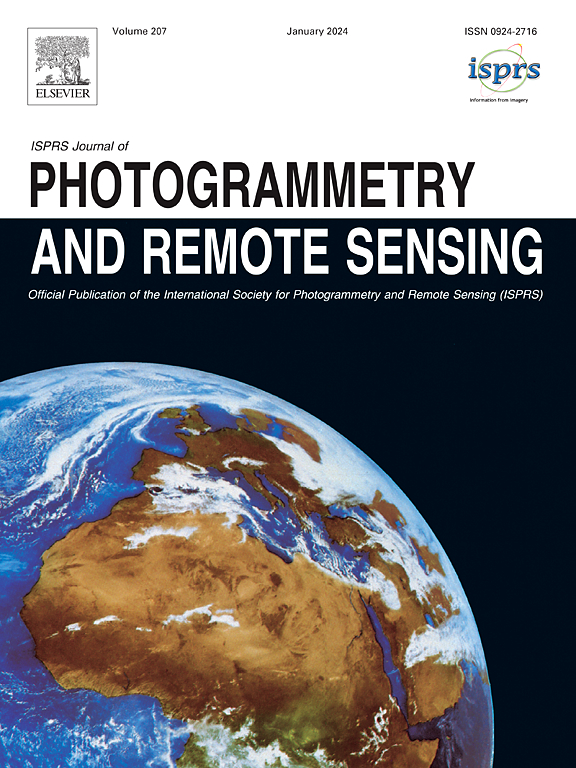遥感影像处理中任何部分模型的系统调查与元分析:挑战、进展、应用与机遇
IF 12.2
1区 地球科学
Q1 GEOGRAPHY, PHYSICAL
ISPRS Journal of Photogrammetry and Remote Sensing
Pub Date : 2025-09-10
DOI:10.1016/j.isprsjprs.2025.08.023
引用次数: 0
摘要
近年来,人工智能(AI)技术深刻改变了遥感领域,从数据收集到分析都带来了革命性的变化。传统的遥感图像解译(RSII)依赖于人工解译和特定任务模型,效率低、成本高、泛化能力差,无法适应大规模数据处理和复杂任务。随着基础模型(FMs)(即大型预训练AI模型)的出现,不仅效率和准确性得到了显著提高,而且各种任务也可以高效地执行。值得注意的是,任何部分模型(SAM)挑战了传统的视觉范式,引起了对任务不可知性视觉模型的广泛兴趣。其卓越的零射击泛化能力在自然场景中表现出色,为RSII的自动化和智能化提供了新的视角和方法。然而,遥感影像与自然影像在空间特征和数据结构上存在显著差异,SAM在RSII中的应用潜力有待全面评估。虽然已有研究证明了SAM在RSII中的适应性,但目前的文献缺乏系统和深入的综述。为了填补这一空白,本研究首次进行了全面的综述和荟萃分析,重点关注SAM在RSII中的挑战、进展、应用和潜力。本文首先回顾了SAM在RS方面的研究进展,并对相关研究成果进行了整理。然后分析了RS的固有挑战,并探讨了SAM在RS中的瓶颈,包括语义信息丢失、训练域与目标域之间的差异、提示依赖性和设计复杂性以及鲁棒性不足。接下来,概述了meta分析的细节,揭示了SAM在遥感图像处理中的研究现状。随后,本文深入研究了SAM在遥感图像处理中的适应方法,并对其在一般和特定遥感任务中的表现进行了评价。最后,对未来的研究方向进行了总结。此外,为了支持该领域的持续发展,已经创建并维护了一个专用的存储库(https://github.com/WanZhan-lucky/WanSAM4RS-Tracker)。本文章由计算机程序翻译,如有差异,请以英文原文为准。
A systematic survey and meta-analysis of the segment anything model in remote sensing image processing: Challenges, advances, applications, and opportunities
In recent years, artificial intelligence (AI) technology has profoundly revolutionized the domain of remote sensing (RS), bringing transformative changes from data collection to analysis. Traditional remote sensing image interpretation (RSII) relies on manual interpretation and task-specific models, which suffer from low efficiency, high costs, and poor generalization, making them inadequate for large-scale data processing and complex tasks. With the emergence of foundational models (FMs) (i.e., large pre-trained AI models), not only has efficiency and accuracy been significantly improved, but diverse tasks can also be executed efficiently. Notably, the segment anything model (SAM) has challenged traditional visual paradigms, sparking widespread interest in task-agnostic visual FMs. Its exceptional zero-shot generalization capability has demonstrated outstanding performance in natural scenes, offering new perspectives and methodologies for the automation and intelligence of RSII. However, there are significant differences in spatial characteristics and data structures between RS images and natural images, meaning the application potential of SAM in RSII has yet to be comprehensively evaluated. Although existing studies have demonstrated SAM’s adaptability in RSII, the current literature lacks systematic and in-depth reviews. To fill this gap, this study conducts a comprehensive review and meta-analysis for the first time, focusing on the challenges, advances, applications, and potential of SAM in RSII. The paper first reviews SAM’s advances in RS and compiles relevant research findings. It then analyzes the inherent challenges of RS and explores the bottlenecks of SAM in RS, including semantic information loss, discrepancies between training and target domains, prompt dependency and design complexity, and insufficient robustness. Next, it outlines the details of the meta-analysis conducted to reveal the research status of SAM in RS. Following that, the paper delves into the adaptation methods of SAM in RS image processing and evaluates its performance in both general and specific RS tasks. Finally, future research directions are summarized. Additionally, to support the continued development of this field, a dedicated repository has been created and maintained (https://github.com/WanZhan-lucky/WanSAM4RS-Tracker).
求助全文
通过发布文献求助,成功后即可免费获取论文全文。
去求助
来源期刊

ISPRS Journal of Photogrammetry and Remote Sensing
工程技术-成像科学与照相技术
CiteScore
21.00
自引率
6.30%
发文量
273
审稿时长
40 days
期刊介绍:
The ISPRS Journal of Photogrammetry and Remote Sensing (P&RS) serves as the official journal of the International Society for Photogrammetry and Remote Sensing (ISPRS). It acts as a platform for scientists and professionals worldwide who are involved in various disciplines that utilize photogrammetry, remote sensing, spatial information systems, computer vision, and related fields. The journal aims to facilitate communication and dissemination of advancements in these disciplines, while also acting as a comprehensive source of reference and archive.
P&RS endeavors to publish high-quality, peer-reviewed research papers that are preferably original and have not been published before. These papers can cover scientific/research, technological development, or application/practical aspects. Additionally, the journal welcomes papers that are based on presentations from ISPRS meetings, as long as they are considered significant contributions to the aforementioned fields.
In particular, P&RS encourages the submission of papers that are of broad scientific interest, showcase innovative applications (especially in emerging fields), have an interdisciplinary focus, discuss topics that have received limited attention in P&RS or related journals, or explore new directions in scientific or professional realms. It is preferred that theoretical papers include practical applications, while papers focusing on systems and applications should include a theoretical background.
 求助内容:
求助内容: 应助结果提醒方式:
应助结果提醒方式:


